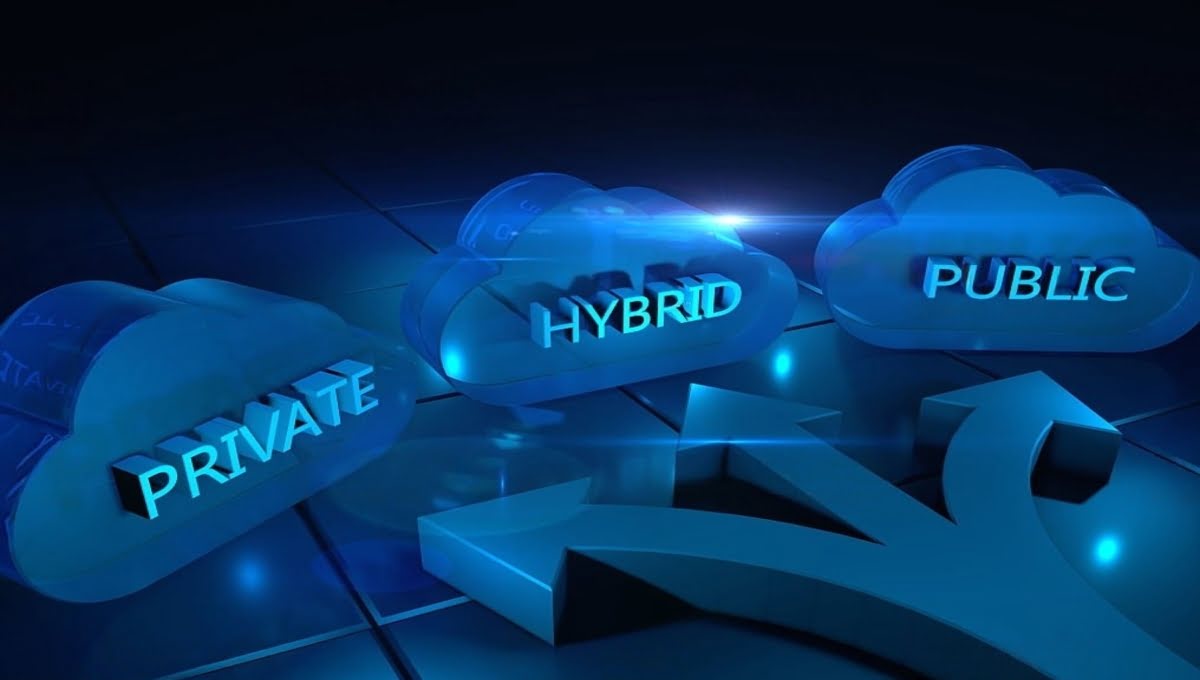FUNDAMENTAL
Main Types of Cloud Computing

Cloud computing has revolutionized the way businesses and individuals store, manage, and access their data and applications. With increasing reliance on technology, understanding the different types of cloud computing has become essential. There are primarily three main types of cloud computing: public cloud, private cloud, and hybrid cloud. Each type offers unique benefits and caters to specific needs. In this article, we’ll delve into the characteristics, advantages, and use cases of these cloud computing models.
Public Cloud: Connecting Through Shared Resources
Public cloud computing involves utilizing third-party service providers’ infrastructure to host applications and services. It operates on a pay-as-you-go model, offering scalability and flexibility. Businesses can access resources such as storage, computing power, and databases without the need for physical hardware maintenance. Amazon Web Services (AWS), Microsoft Azure, and Google Cloud Platform (GCP) are three well-known public cloud service providers.
Advantages of Public Cloud
- Cost-effectiveness: Pay-per-use model eliminates upfront investments in hardware and software.
- Scalability: Easily adjust resources to meet fluctuating demands, whether scaling up during peak usage or downsizing during off-peak periods.
- Speed and agility: Rapid deployment of applications and infrastructure, accelerating time-to-market.
- Global reach: Access to a vast network of data centers worldwide, enabling global operations.
- High availability: Robust infrastructure with redundancy and failover mechanisms ensuring continuous service.
- Focus on core competencies: Outsource IT infrastructure management, allowing businesses to concentrate on core operations.
- Latest technology: Access to the latest technologies and innovations without significant capital expenditure.
Disadvantages of Public Cloud
- Security concerns: Sharing infrastructure with other organizations raises potential security risks.
- Vendor lock-in: Reliance on a single provider can make it difficult to switch to another.
- Limited control: Reduced control over infrastructure compared to on-premises solutions.
- Internet dependency: Reliance on a stable internet connection for accessing cloud services.
- Data privacy concerns: Data stored in the cloud might be subject to legal and regulatory restrictions.
Applications of Public Cloud
The public cloud has a wide range of applications across various industries:
- IT Infrastructure:
- Virtualization
- Storage
- Networking
- Database management
- Software Development:
- Platform as a Service (PaaS) for application development
- Infrastructure as a Service (IaaS) for hosting development environments
- Business Applications:
- Customer relationship management (CRM)
- Enterprise resource planning (ERP)
- Human capital management (HCM)
- Data Analytics:
- Big data processing
- Business intelligence
- Machine learning
- Mobile Application Development:
- Backend infrastructure for mobile apps
- Mobile application development platforms
- E-commerce:
- Hosting online stores
- Order processing
- Payment processing
- Education:
- Online learning platforms
- Virtual classrooms
- Student information systems
- Healthcare:
- Electronic health records
- Telemedicine
- Medical image storage
Private Cloud: The Exclusive Cloud Environment
A private cloud offers a dedicated infrastructure exclusively for one organization. This model provides greater control over security, compliance, and customization. While it requires more investment and management, it’s suitable for businesses with strict data privacy requirements, like government agencies or financial institutions.
Advantages of private clouds:
- Enhanced Security: As resources are dedicated to a single organization, security measures can be tailored to specific needs, reducing the risk of data breaches.
- Greater Control: Organizations have full control over the cloud environment, including hardware, software, and security configurations.
- Compliance: Easier to meet industry regulations and compliance standards due to complete control over the environment.
- Predictable Performance: Dedicated resources lead to consistent and predictable performance, especially for critical applications.
- Data Sovereignty: Data remains within the organization’s control, addressing concerns about data privacy and sovereignty.
Disadvantages of Private Cloud
- Higher Costs: Requires significant upfront investment in hardware, software, and IT personnel for setup and maintenance.
- Limited Scalability: Expanding resources can be time-consuming and costly compared to public cloud options.
- Lack of Innovation: May be slower to adopt new technologies and trends compared to public cloud providers.
- Ongoing Management: Requires dedicated IT staff to manage and maintain the infrastructure.
Applications of Private Cloud
- Highly Regulated Industries: Financial institutions, healthcare providers, and government agencies often prefer private clouds due to stringent data security and compliance requirements.
- Enterprise Applications: Critical business applications that demand high performance, security, and control can benefit from private cloud deployments.
- Legacy Systems: Modernizing legacy systems by migrating them to a private cloud can improve performance and efficiency.
- Hybrid Cloud Environments: Private clouds can serve as a foundation for hybrid cloud strategies, combining the benefits of both private and public clouds.
- Data Centers: Organizations with existing data centers can transform them into private clouds to leverage cloud computing benefits while maintaining control over their infrastructure.
Hybrid Cloud: Merging Flexibility and Security
The hybrid cloud combines elements of both public and private clouds. It allows businesses to manage workloads dynamically, optimizing resource allocation. Sensitive data can be stored in the private segment, while less sensitive operations can utilize the public cloud. This model provides enhanced flexibility and cost-efficiency, making it an ideal solution for organizations with varying workload demands.
Advantages of Hybrid Cloud
- Flexibility: Combines the best of both worlds, allowing organizations to leverage public cloud for scalability and cost-efficiency while maintaining control over sensitive data and applications in a private cloud.
- Cost Optimization: Optimizes resource allocation by using public cloud for burstable workloads and private cloud for consistent workloads, resulting in cost savings.
- Disaster Recovery: Leveraging public cloud as a backup or disaster recovery site enhances business continuity.
- Improved Performance: Delivers optimal performance by running latency-sensitive applications on-premises while using public cloud for less critical workloads.
- Data Sovereignty: Maintains control over sensitive data by keeping it within the organization’s private cloud.
Disadvantages of Hybrid Cloud
- Complexity: Managing multiple environments can be complex and requires skilled IT personnel.
- Security Challenges: Ensuring consistent security across both public and private clouds can be difficult.
- Integration Challenges: Integrating applications and data between the two environments can be complex and time-consuming.
- Vendor Lock-In: Reliance on specific cloud providers for public cloud services can create vendor lock-in challenges.
Applications of Hybrid Cloud
- Disaster Recovery and Business Continuity: Utilizing public cloud as a backup or failover site to ensure business continuity during disruptions.
- Workload Optimization: Migrating less critical workloads to the public cloud to reduce costs and improve scalability while keeping sensitive data on-premises.
- Application Modernization: Modernizing legacy applications by gradually migrating components to the public cloud while maintaining core functionalities on-premises.
- DevOps and Agile Development: Accelerating development and deployment cycles by using public cloud for development and testing while deploying applications to a private cloud for production.
- Big Data and Analytics: Utilizing public cloud for data processing and analytics while maintaining data security and compliance in a private cloud.
In essence, hybrid cloud offers flexibility, cost optimization, and disaster recovery benefits while introducing complexity and security challenges. It is suitable for organizations that require a balance of control, cost-efficiency, and scalability.
Additional Tips:
- Be sure to cite any sources you used when gathering information for your article.
- Use your own words and sentence structure to avoid unintentional plagiarism.
- Paraphrase information instead of copying it directly.
- Use quotation marks when including direct quotes from other sources.
By following these suggestions, you can ensure the originality and integrity of your work while providing valuable insights to your readers.
Conclusion
In a technology-driven world, cloud computing has become the backbone of modern business operations. The three main types of cloud computing—public, private, and hybrid—offer tailored solutions for diverse needs. Organizations must assess their requirements, security concerns, and scalability needs before choosing the right cloud model. By embracing cloud computing, businesses can unlock new levels of efficiency, innovation, and growth.
FAQs
What is the primary distinction between public and private clouds?
Public clouds share resources among multiple users, while private clouds offer dedicated infrastructure for a single organization.
Can I switch from one cloud model to another?
Yes, businesses can transition between cloud models, but it requires careful planning and data migration.
How does cloud computing enhance business continuity?
Cloud computing ensures data redundancy and allows for quick disaster recovery, minimizing downtime.
What are the potential drawbacks of hybrid clouds?
Managing a hybrid environment can be complex, requiring expertise in both public and private cloud management.
Is cloud computing suitable for small businesses?
Yes, cloud computing offers cost-effective solutions for small businesses, enabling them to access advanced resources without heavy upfront investments.

 FUNDAMENTAL1 year ago
FUNDAMENTAL1 year agoHow Cloud Computing Improving Customer Service Processes

 FUNDAMENTAL3 months ago
FUNDAMENTAL3 months agoWhat is cloud computing? A Comprehensive Guide

 CLOUD COMPUTING12 months ago
CLOUD COMPUTING12 months agoWhat Is Vlan and VSAN In Cloud Computing?

 FUNDAMENTAL12 months ago
FUNDAMENTAL12 months agoHow can Cloud Technology Help Small Businesses ?

 CLOUD COMPUTING11 months ago
CLOUD COMPUTING11 months agowhat is cloud bursting in cloud computing

 FUNDAMENTAL3 months ago
FUNDAMENTAL3 months agoEvolution of Cloud Computing : A Well-Explained

 FUNDAMENTAL3 months ago
FUNDAMENTAL3 months agowhat is IaaS PaaS and SaaS in cloud computing

 FUNDAMENTAL11 months ago
FUNDAMENTAL11 months agoWhat is data security in cloud computing : A Comprehensive Guide











